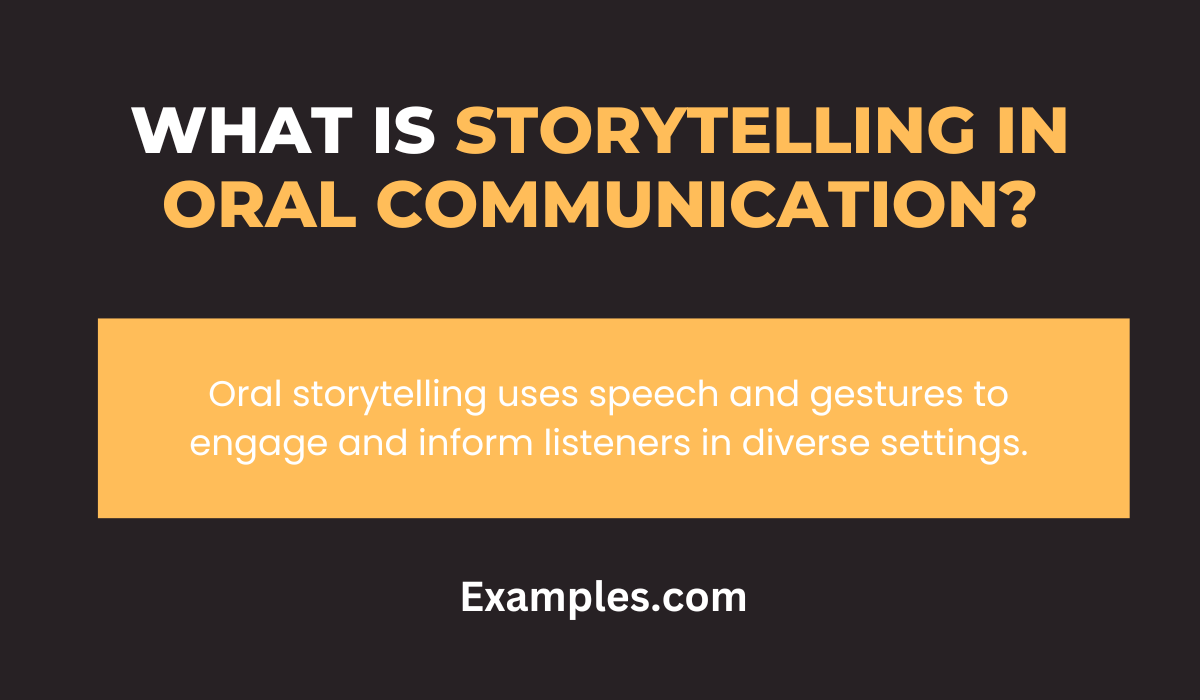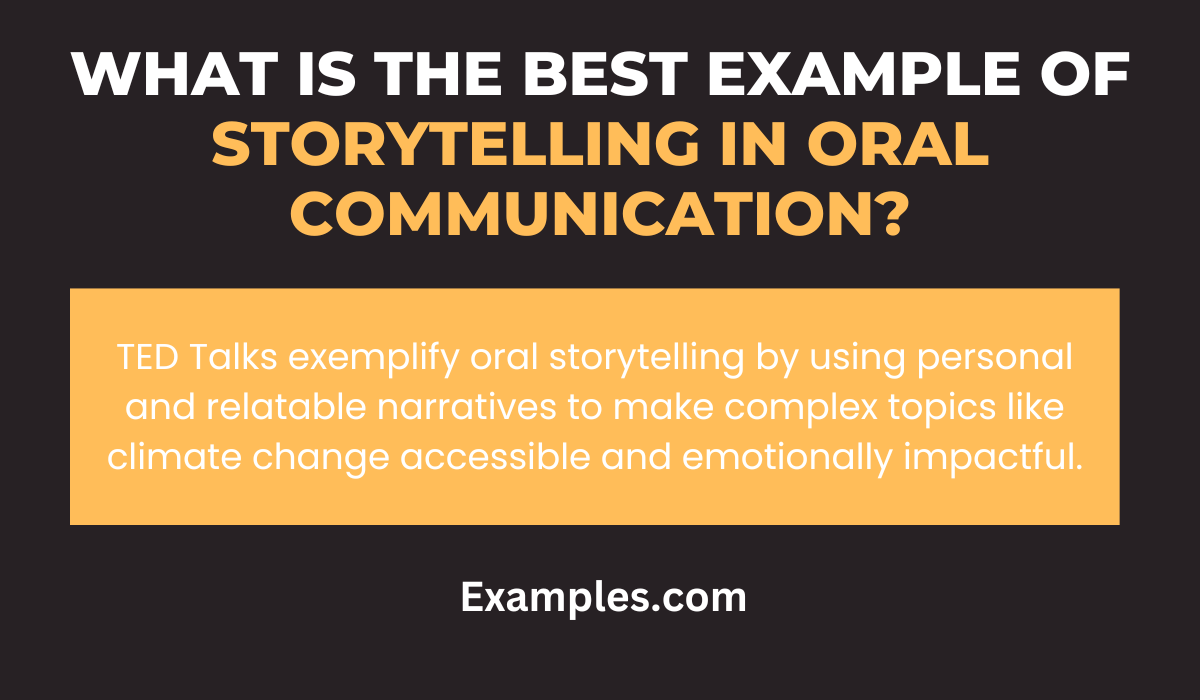29+ Storytelling in Oral Communication Examples
Oral communication is an art, and storytelling is its most captivating form. This guide delves into the nuances of storytelling within oral communication, offering a rich collection of examples to illustrate how stories can effectively convey messages, engage audiences, and leave a lasting impact. Whether you’re a teacher, student, or professional, these examples and tips will enhance your communication skills, making your presentations, lectures, or speeches more memorable and effective. Dive into the world of storytelling and transform your oral communication today!
What is Storytelling in Oral Communication?

Storytelling in oral communication refers to the technique of conveying messages, ideas, or narratives through spoken words, often accompanied by gestures, expressions, and vocal modulation. This method is used to engage, inform, and entertain an audience, making the communication process more effective and memorable. Storytelling can range from simple anecdotes to complex narratives, each tailored to suit the context and audience. This approach is widely used in various settings, including education, business, public speaking, and everyday conversations.
What is the Best Example of Storytelling in Oral Communication?

The best example of storytelling in oral communication is often found in TED Talks, where speakers use personal anecdotes, historical tales, or fictional narratives to illustrate their points. For instance, a TED speaker discussing climate change might share a personal story about witnessing the effects of environmental degradation, connecting the global issue to a relatable human experience. This approach not only makes the topic more accessible but also creates an emotional connection with the audience, enhancing the impact of the message. Such storytelling examples demonstrate the power of narrative in making complex or abstract concepts understandable and engaging.
30 Storytelling in Oral Communication Examples
Discover 30 unique storytelling examples in oral communication, showcasing the art of engaging narratives in various contexts. From TED Talks to personal anecdotes, historical tales, and impactful speeches, these examples highlight the effectiveness of storytelling in making complex concepts relatable and memorable. This collection is a treasure trove for anyone looking to enhance their communication skills through the power of storytelling, with a focus on emotional connection, vivid imagery, and persuasive delivery. Ideal for educators, public speakers, and communicators, these examples are rich in keywords and NLP-friendly, providing insights into the dynamic world of storytelling.
- Using Personal Anecdotes in Business Presentations:
Personal stories in business settings make concepts tangible and relatable.
Example: “When I started my first business, I faced challenges that taught me the importance of resilience.” - Historical Stories in Educational Lectures:
Historical narratives make lessons engaging and informative.
Example: “Consider how the Roman Empire’s strategies can apply to modern leadership principles.” - Emotional Narratives in Charity Events:
Emotional stories at charity events create empathy and drive action.
Example: “Meeting those affected by the disaster moved me to start this fundraiser.” - Humorous Tales in Public Speaking:
Humor in storytelling makes messages memorable and enjoyable.
Example: “My first attempt at cooking was so disastrous, it could’ve made a hilarious sitcom episode!”

- Motivational Stories in Coaching:
Inspiring stories in coaching sessions boost morale and motivation.
Example: “Overcoming my fear of heights through skydiving changed my perspective on challenges.” - Fictional Scenarios in Creative Workshops:
Fictional stories in workshops spark imagination and creativity.
Example: “Imagine a world where technology solves all our environmental issues.” - Cultural Tales in Diversity Training:
Sharing cultural stories in diversity training fosters understanding and inclusivity.
Example: “In my culture, this festival symbolizes unity and harmony.” - Anecdotes in Medical Counseling:
Personal anecdotes in counseling help in explaining medical conditions empathetically.
Example: “I had a patient who successfully managed their condition through these lifestyle changes.” - Success Stories in Marketing Pitches:
Success stories in pitches demonstrate the product’s impact and potential.
Example: “Our software helped a small business triple its revenue in one year.” - Myths and Legends in Literature Classes:
Myths enhance literature classes by exploring timeless themes and morals.
Example: “Let’s discuss how this Greek myth reflects our topic of heroism.” - Customer Testimonials in Sales Presentations:
Testimonials in sales provide real-world proof of product effectiveness.
Example: “Our clients saw a 50% increase in efficiency using our solution.” - Life Lessons in Graduation Speeches:
Graduation speeches using life lessons inspire and guide new graduates.
Example: “Facing adversity in my career taught me the value of perseverance.” - Adventure Stories in Travel Blogs:
Adventure narratives in blogs capture the excitement of travel.
Example: “Scaling the Andes was an exhilarating reminder of nature’s wonders.” - Case Studies in Professional Workshops:
Case studies in workshops offer practical, real-life industry insights.
Example: “Analyzing this company’s turnaround strategy reveals key business lessons.” - Folktales in Children’s Storytelling:
Folktales in children’s storytelling convey morals in an engaging way.
Example: “Once upon a time, a clever rabbit outwitted a fox, teaching us about intelligence over strength.”

- Biographical Stories in Documentary Narratives:
Biographies in documentaries add depth and context to historical figures.
Example: “This scientist’s perseverance amidst adversity changed our world.” - Fantasy Stories in Creative Writing:
Fantasy stories in writing classes fuel imagination and originality.
Example: “In a land where dragons and humans coexist, a unique friendship formed.” - War Stories in History Classes:
War narratives in history classes bring historical events to life.
Example: “The soldier’s diary gives us a poignant view of the realities of war.” - Inspirational Quotes in Motivational Seminars:
Quotes in seminars provide concise, powerful inspiration.
Example: “‘The only limit to our realization of tomorrow is our doubts of today.’ – FDR” - User Experience Stories in Tech Demonstrations:
User stories in tech demos show practical applications and benefits.
Example: “Our app helped a visually impaired user navigate the city independently.” - Survival Tales in Adventure Courses:
Survival stories in adventure courses teach resilience and resourcefulness.
Example: “Stranded in the wilderness, I learned the importance of staying calm under pressure.” - Parables in Religious Teachings:
Parables in religious contexts impart spiritual lessons effectively.
Example: “The parable of the Good Samaritan teaches us about compassion.” - Success Stories in Career Counseling:
Sharing success stories in counseling motivates career growth.
Example: “Hearing about alumni achievements inspires current students to aim high.” - Historical Anecdotes in Political Speeches:
Historical anecdotes in politics draw parallels and offer lessons.
Example: “Recalling past leaders’ challenges helps us navigate today’s issues.”

- Family Stories in Social Gatherings:
Family anecdotes at gatherings strengthen bonds and share heritage.
Example: “My grandmother’s journey to this country is a testament to her strength.” - Scientific Discoveries in Lectures:
Discussing discoveries in science lectures stimulates curiosity and learning.
Example: “The story of how penicillin was discovered highlights serendipity in science.” - Professional Journeys in Networking Events:
Sharing career paths at networking events offers insights and guidance.
Example: “Navigating my career shift from finance to tech was challenging but rewarding.” - Cultural Anecdotes in Travel Guides:
Cultural stories in travel guides enrich the understanding of destinations.
Example: “In Japan, the art of tea-making is more than a drink; it’s a ceremony.” - Behind-the-Scenes Stories in Film Discussions:
Discussing the making of films adds depth to the viewing experience.
Example: “Learning about the challenges faced while filming adds to our appreciation of the movie.” - Ethical Dilemmas in Philosophy Classes:
Discussing ethical scenarios in classes provokes critical thinking.
Example: “Imagine you’re faced with the trolley problem; what would be your choice and why?”
These examples span a wide range of contexts, illustrating the versatility and impact of storytelling in effectively communicating ideas, emotions, and lessons.
What are the Benefits of Storytelling in Oral Communication?
Storytelling in oral communication is a powerful tool that transcends the mere exchange of information. It’s a technique that enriches the communication process, making it more effective, engaging, and memorable. Here are six key points that capture the essence of storytelling in oral communication:
- Facilitates Effective Communication: Stories translate abstract concepts into concrete examples, making communication clearer and more effective.
- Strengthens Memory and Recall: The narrative structure of stories aids in memory retention, allowing listeners to remember and recount the information easily.
- Supports Assertive Communication: Storytelling can assert a point of view effectively, allowing the speaker to express ideas confidently without being aggressive.
- Breaks Down Communication Barriers: Stories transcend cultural and linguistic barriers, making them an effective tool for Intercultural Communication.
- Develops Good Communication Skills: Regular storytelling practices hone a speaker’s communication skills, making them more articulate and expressive.
- Enriches Therapeutic Communication: In therapeutic settings, storytelling can be a powerful tool to explore emotions and experiences.
How Does Storytelling Help People to Oral Communicate?
Storytelling in oral communication is not just about telling a story; it’s a dynamic process that facilitates the exchange of ideas, emotions, and values in a compelling way. Here’s how it helps in oral communication:
- Enhances Clarity: Through storytelling, complex ideas are broken down into simpler, relatable narratives, making the message clearer and easier to understand.
- Builds Rapport: Sharing stories creates a sense of trust and connection, essential for Interpersonal Communication.
- Improves Listener Engagement: A compelling story captures the listener’s attention, making the communication process more interactive and engaging.
- Facilitates Emotional Expression: Storytelling allows speakers to express emotions effectively, vital for Empathetic Communication and building rapport.
- Encourages Active Listening: Good stories make listeners more attentive, an essential aspect of Effective Communication.
- Supports Nonverbal Communication: Through storytelling, speakers can effectively use gestures, facial expressions, and voice modulation to enhance their message.
Importance of Storytelling in Oral Communication
Storytelling in oral communication is a powerful tool that transcends mere words, transforming messages into engaging, memorable experiences. It bridges gaps between individuals and ideas, making it a cornerstone in various forms of communication. Here are six key points highlighting its importance:
- Emotional Resonance: Storytelling evokes emotions, making messages more relatable and impactful. It taps into the listener’s feelings, creating a deeper connection than factual communication alone.
- Enhanced Memory Recall: Stories are more easily remembered than abstract information. This is crucial in educational settings, business presentations, and even in day-to-day conversations.
- Simplifies Complex Ideas: Through storytelling, complex or abstract concepts are broken down into simpler, more digestible narratives. This method is particularly effective in fields like science, technology, and mathematics.
- Cultural and Social Connection: Stories often reflect cultural values and social norms, fostering a sense of community and shared understanding. This aspect is vital in intercultural communication and social bonding.
- Improves Communication Skills: Regular storytelling enhances one’s ability to express thoughts clearly and compellingly, a key component in effective communication.
- Encourages Active Listening: A well-told story captures the audience’s attention, promoting active listening and engagement, essential elements in interpersonal communication.
Methods of Storytelling in Oral Communication
To effectively leverage storytelling in oral communication, various methods can be employed, each suited to different contexts and objectives. Here are some key approaches:
- Personal Anecdotes: Sharing personal experiences makes the story relatable and authentic, enhancing empathetic communication. It’s a powerful tool in motivational speaking and personal branding.
- Visual Aids: Incorporating visual elements like slides, images, or physical props can enhance the storytelling experience, particularly in educational settings and business presentations.
- Dramatization: Using voice modulation, gestures, and facial expressions adds drama and interest to the story. This method is especially effective in public speaking and theatrical performances.
- Interactive Storytelling: Engaging the audience with questions or inviting them to contribute to the story fosters participation and maintains interest. This is useful in workshops and training sessions.
- Narrative Structure: Organizing the story with a clear beginning, middle, and end helps in maintaining a coherent flow. This structure is crucial in all forms of storytelling, including mass communication and corporate presentations.
- Use of Metaphors and Analogies: These devices help in explaining complex ideas by relating them to familiar concepts, enhancing understanding in fields like science and technology communication.
- Digital Storytelling: Leveraging digital platforms and communication technology, like podcasts or social media, can reach a wider audience, making it ideal for global communication challenges and marketing.
- Cultural Stories: Integrating cultural narratives or folklore can bring a unique perspective, particularly in intercultural communication and diversity training.
Storytelling in oral communication is a captivating art that enhances message delivery, engaging and connecting with audiences profoundly. This guide offers valuable examples and tips, empowering teachers, students, and professionals to transform their presentations and speeches, making them more memorable and impactful. It’s a journey into mastering the art of storytelling to elevate communication skills.
For further exploration into the art of storytelling in communication, TED offers insightful resources on how to effectively use storytelling as a communication tool. This includes advice from TED’s head curator, Chris Anderson, on storytelling dos and don’ts, as well as an app-based course for developing TED-style talks (TED’s Guide on Storytelling). Additionally, Maven provides a comprehensive guide on 15 storytelling techniques, helping writers, speakers, and marketers craft compelling narratives that build tension, evoke emotions, and captivate audiences.



